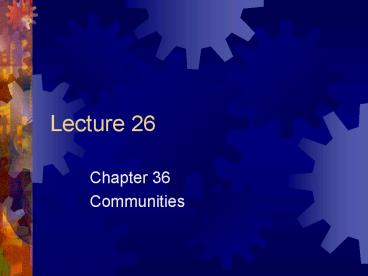Communities - PowerPoint PPT Presentation
1 / 23
Title:
Communities
Description:
Discuss the role of disturbance in communities. Fire in Yellowstone. Flood in ... There is an alga, eaten by a shrimp, eaten by a surfperch, eaten by a heron ... – PowerPoint PPT presentation
Number of Views:30
Avg rating:3.0/5.0
Title: Communities
1
Lecture 26
- Chapter 36
- Communities
2
Learning Objectives
- Define disturbance
- Discuss the role of disturbance in communities
- Fire in Yellowstone
- Flood in Grand Canyon
- Contrast open and serotinous pine cones
- Recall what NPS USGS stand for
3
Disturbance
- A disruption in the community
- Typically involves an abiotic force (we often
call disasters) - Fires
- Storms
- Drought
- Flood
- Volcano
4
Disturbance is Natural
- Despite disaster label, disturbance is natural,
and often necessary - Example prairies need fire every 2-3 years
- Keeps trees from taking over
- Recycles nutrients to soil
- Clears away dead grass, allowing sunlight air
to penetrate
5
Disturbance Humans
- People like to prevent disasters or natural
disturbances - Put out forest fires
- Dam rivers to control flooding
- This can affect ecological communities negatively
6
Natural Fires in Yellowstone Park
- A dozen natural fires in average year
- Caused by lightning
- Usually small ground fires (a few to 100 or so
acres) - Patchy
- Heat not too intense (many trees can survive)
7
Benefits of Fire
- Nutrients recycled
- Undergrowth cleared
- Allows sunlight to penetrate
- Lush grass, flower growth encouraged
- Bottom line fire can beneficial
8
Lodgepole Pine
- The dominant tree in Yellowstone
- Makes 2 kinds of pine cones
- Open cones
- Seeds fall out immediately
- Serotinous cones
- Require fire to open
- Cone coated in resin
- Seeds stay inside until fire
- Can stay on tree for years
- Quickly reseed burnt areas
9
Fire Suppression
- Fire suppression by National Park Service (NPS)
began when park opened - Every fire quickly put out (natural or not)
- Problem fuel for fires accumulated year, after
year, after year, then
10
Fire Season of 1988
- Summer 1988 park basically exploded!
- Decades of fuel built up
- Dry conditions, little rain
- Crown fires in tops of trees
- Too big, too hot to fight
11
Aftermath of Fire
- Originally, thought to be great tragedy
- Nature recovered
- Park Service came under nation-wide scrutiny
- Cost of fire suppression 10X annual park budget
(guess who pays)
12
Grand Canyon Flooding
- Flood disturbance was natural part of ecosystem
- Maintained depth of river
- Replenished sand on beaches
- Cleared vegetation
13
Dam Disrupts Flooding
- Dam in Glen Canyon region of Grand Canyon for
flood control - Over time, environmentalists anglers worried
about habitat alteration
14
Flood Experiment
- United States Geological Survey (USGS)
- Decides to try flood experiment
- March to April 1996, allows river to flood
experimentally - River returned to more natural state
15
Grand Canyon Floods
- USGS Websites
- Rationale for experiment website 1
- Grand Canyon Flows
- Grand Canyon Sand
16
Trophic Level Diet
- Primary producers autotrophs, chemotrophs
- Heterotrophs include
- Primary Consumers herbivores
- All carnivores, which include
- Secondary consumers
- Tertiary consumers
- Quaternary consumers
17
Question
- There is an alga, eaten by a shrimp, eaten by a
surfperch, eaten by a heron - Using trophic level terminology, how would you
describe the surfperch?
18
Question
- What kind of heterotroph does not eat meat?
19
Question
- What is the lowest level heterotroph which eats
meat?
20
Problem with Food Chains
- Food chains arent realistic
- Few communities are so simple
- Some species defy classification
- Hawk can eat mice or snakes
- Raccoons eat vegetation and meat
21
Food Webs
- Food webs are more realistic depiction
- Consist of several intertwined food chains
22
Limited Length of Food Chains/Webs
- Remember 2nd Law of Thermodynamics
- Some energy lost in every conversion
- Metabolic efficiency typically 10
- 90 loss at each level
- Only a few pyramid levels can be supported (3 to
5)
23
Meat is Energetically Expensive
- Just as with any food chain, there is loss at
every level - Meat requires greater land water resources































